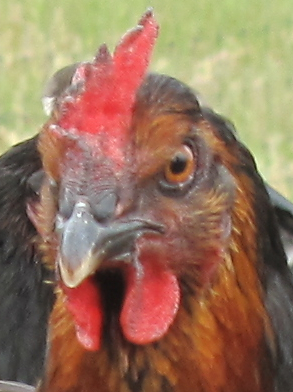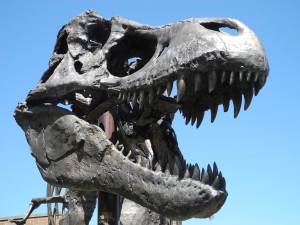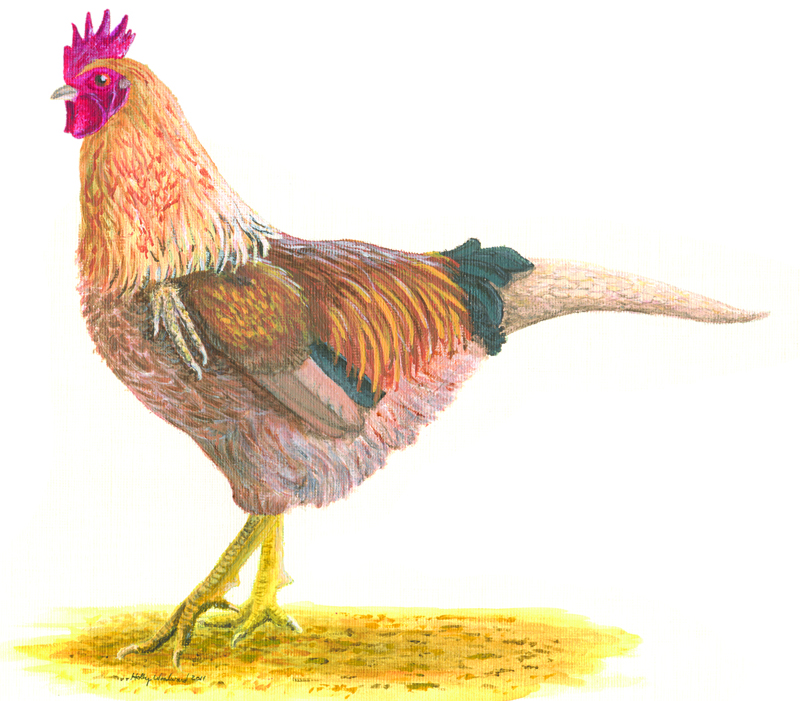 Have you ever looked at a chicken? I mean really looked, and not the kind that comes safely shrink-wrapped in a Styrofoam tray? There’s something in the eyes, something still-wild, almost menacing—no, really menacing. Given a little room to move around and enough conspecifics to elicit social behaviors, the animals are aggressive, territorial, and relentlessly voracious. If you spend much time around the birds, you start to feel grateful for our size advantage. These are, after all, the living descendents of dinosaurs.
Have you ever looked at a chicken? I mean really looked, and not the kind that comes safely shrink-wrapped in a Styrofoam tray? There’s something in the eyes, something still-wild, almost menacing—no, really menacing. Given a little room to move around and enough conspecifics to elicit social behaviors, the animals are aggressive, territorial, and relentlessly voracious. If you spend much time around the birds, you start to feel grateful for our size advantage. These are, after all, the living descendents of dinosaurs.
And yet … there’s something a little underwhelming about the whole birds-are-dinosaurs thing. Living birds, chickens included, share thousands of traits with their extinct forebears. But there’s a certain chill-inducing it-factor that even the most dangerous modern birds just don’t have. One imagines it must be a little like hanging out with Muhammed Ali nowadays, or George Foreman. It would be great—fascinating, inspiring even. But nowhere near as awesome as being around them back in their prime, when they were huge, lethal and unpredictable.
Fortunately, someone is trying to do something about the sad state of our feathered friends, by freeing aspects of the ancestral dinosaur that still lurk within the avian genome. You can read all about it in the October issue of Wired.

This enterprise raises a question, though: where exactly along the transition from terrible lizard to cranky-but-harmless barnyard fowl did dinosaurs finally become birds? When did the dinosaur lineage lose its major mojo, in other words, and what combination of changes would it take to get that awesomeness back? Even with revived dinosaurian characteristics, would you really have a chickenosaurus—or just a very odd chicken?
Jack Horner, the Montana paleontologist behind the idea, hasn’t actually made his dino-chicken yet. But there is tempting evidence that such atavistic characters as longer tails, pointy teeth and clawed hands might all be within relatively easy reach, via molecular “switches” that can turn on or off different developmental programs during the growth from fertilized egg to full-grown adult. Accumulate enough body form changes like these, Horner reasons, and you’ll eventually end up with something that truly deserves the “saurus” suffix. And all without the mess and expense of cloning or transgenics.
 Does it matter that the first chickenosaurus might be a uniquely funky chicken, rather than a truly terrible lizard? For Horner, for now at least, an oddball chicken might be enough. A couple of years ago he had a student draw up a sketch of what a first generation chickenosaurus might look like: it’s a chicken, sure enough, but with a dapper little three-clawed hand at the front of its wing, and a stubby, bald tail jutting out behind. Honestly, it’s probably closer to Napoleon Dynamite’s liger drawing than anything from The Lost World. It’s awesome…ish. But certainly more creepy-cute than terrifying.
Does it matter that the first chickenosaurus might be a uniquely funky chicken, rather than a truly terrible lizard? For Horner, for now at least, an oddball chicken might be enough. A couple of years ago he had a student draw up a sketch of what a first generation chickenosaurus might look like: it’s a chicken, sure enough, but with a dapper little three-clawed hand at the front of its wing, and a stubby, bald tail jutting out behind. Honestly, it’s probably closer to Napoleon Dynamite’s liger drawing than anything from The Lost World. It’s awesome…ish. But certainly more creepy-cute than terrifying.
Horner insists that he wants a pet dinosaur, and always has. Fair enough. But there’s a deeper goal to the chickenosaurus project, too. Horner worries that dinosaur paleontology, a field he has helped define over a long career, has itself become fossilized in ancient techniques. He’s hoping that a dino chicken might spur new discoveries in the genetics, behavior and evolution of long-extinct dinos, and help push forward the “wet” paleontology of genomics and developmental biology.
It’s not likely that the NSF will be putting out a request for proposals in reverse evolution anytime soon. But that doesn’t bother Horner either. He hasn’t written a traditional grant proposal in years, relying instead on private donations and his consulting gigs to pay for his research program.
In fact, you won’t find it advertised in the usual places, but Horner has a plum job opening in his research group. Thanks to a big Hollywood director (no, not that one), he’s got funding for a postdoc to head up the chickenosaurus project. He’s just looking for the right person. So what are you waiting for? If you’ve got a PhD, a rebellious streak and mad developmental biology bench skills, this could be your chance to (re)make history.
***
Chickenosaurus drawing: Holly Woodward. Chicken and T. rex skeleton shots by the author.
I spent my childhood looking into chickens’ eyes — I really did — and they’re just as you say, vicious and aggressive, but also dumb. Aggressively dumb. I’m pretty sure that’s a clue to their wired-in characters and if you add hugeness to that equation, I think what you have is not a pet. Caveat: Christie might differ on their characters.
Excellent post, Tom. More, please.
Very intriguing article, among many others. It reminds me of a “reverse evolution” Nature letter in which a Stanford group was able to re-create the penile spines of primates that were lost during human evolution. If penis-spike research can be supported by government grants maybe there is hope for a government sponsored Jurassic Park. I won’t hold my breath.
Ann, I’d like to hear more about your barnyard adventures some day! There were a couple of childhood years when I split my time, pretty evenly, between looking into chicken’s eyes and into bullies’ eyes. I may be conflating a couple of characteristics unfairly, but “aggressively dumb” seems to cover a lot of my memories.
But, then, of course, most dinosaur species weren’t actually huge and lethal. Most were small, or herbivorous, and I’m sure a lot of them were dumb.
Tom, the meanest animal I’ve ever encountered in my life was a banty rooster. (Banty=bantum=tiny little bird.)
If dinosaurs were mean, then that little red bastard had lots of dino in him.
Interesting aricle and that’s a good point that there is a lot of Dinosaur like features in many animals.
Reverse Evolution. Now THAT would be cool. But it does bring forth disturbing images from Jurassic Park though where humans are being hunted by the dinosaurs, or in this case, the chickenosaurus (!). And yes, I do agree with you on the eyes. I find them quite eerie. There’s something menacing in those eyes. It’s as if they’re plotting something evil. Despite the size, chickens don’t look like they can be bullied too. Try scaring them off and notice how it moves in an offensive manner with wings flapping and all.
I agree.. I have a dino-chicken as well in my blog 🙂
http://2.bp.blogspot.com/-JrQwaXft-e8/TWVYWhFQXEI/AAAAAAAAAKI/V4nFJI4RyaI/s1600/growup.jpg
Love your images, Natalia, especially “that last day does not bring extinction to us…”